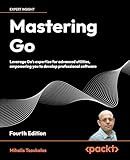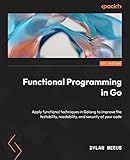Best Golang Interface Guides to Buy in December 2025

Learning Go: An Idiomatic Approach to Real-World Go Programming



Go Programming Language, The (Addison-Wesley Professional Computing Series)



System Programming Essentials with Go: System calls, networking, efficiency, and security practices with practical projects in Golang



Mastering Go: Leverage Go's expertise for advanced utilities, empowering you to develop professional software



Go Programming - From Beginner to Professional: Learn everything you need to build modern software using Go



Functional Programming in Go: Apply functional techniques in Golang to improve the testability, readability, and security of your code



Black Hat Go: Go Programming For Hackers and Pentesters
- LEARN GO WITH A HACKER'S PERSPECTIVE FOR PRACTICAL SECURITY SKILLS.
- PAPERBACK FORMAT FOR EASY READING AND REFERENCE ON-THE-GO.
- ESSENTIAL FOR PENTESTERS: ENHANCE YOUR TOOLKIT WITH ADVANCED TECHNIQUES.


In Golang, it is possible to pass an interface as a parameter to a function. This allows for greater flexibility and reusability in code.
To pass an interface as a parameter, you need to define the function signature with the interface type specified as the parameter. For example, if you have an interface named MyInterface, you can define a function like this:
func someFunction(myInterface MyInterface) { // Function body // Access methods and properties defined in MyInterface within this function }
Once the function is defined, you can call it and pass any object that implements the MyInterface interface as an argument. This means that the object must provide all the methods defined in the interface.
Here's an example of how to pass an interface as a parameter:
type MyInterface interface { SomeMethod() }
type MyStruct1 struct {}
func (m MyStruct1) SomeMethod() { fmt.Println("SomeMethod in MyStruct1") }
type MyStruct2 struct {}
func (m MyStruct2) SomeMethod() { fmt.Println("SomeMethod in MyStruct2") }
func someFunction(myInterface MyInterface) { myInterface.SomeMethod() }
func main() { myStruct1 := MyStruct1{} myStruct2 := MyStruct2{}
someFunction(myStruct1) // Output: SomeMethod in MyStruct1
someFunction(myStruct2) // Output: SomeMethod in MyStruct2
}
In the above example, MyInterface is an interface that requires objects implementing it to have a SomeMethod() function. MyStruct1 and MyStruct2 both implement the MyInterface.
The someFunction takes an argument of type MyInterface, so it can accept both MyStruct1 and MyStruct2 objects. Within the function, you can call methods defined in the interface on the passed object. This allows you to work with different types while using a common interface.
What is the purpose of the empty interface in Golang?
In Golang, an empty interface is represented by the interface{} type. It is sometimes called the "empty interface" because it has no declared methods. The purpose of this empty interface is to be a type that can hold values of any type.
The empty interface allows for the flexibility of accepting values of any type or allowing any type to be returned from a function. It is commonly used in scenarios where the type of a value is unknown or can vary, such as when dealing with collections of data of different types or when using reflection to examine and manipulate values.
By using the empty interface, Go provides a way to write generic code that doesn't rely on specific types, allowing for dynamic and flexible behavior. However, it should be used with caution as it sacrifices type safety, and type assertions or type switches might be necessary to handle values of specific types when using empty interfaces.
What is the role of interfaces in Golang programming?
In Golang programming, interfaces serve as a contract that defines a set of methods that a type must implement. They allow different types to be treated as the same kind of object, facilitating polymorphism.
The main role of interfaces in Golang can be summarized as follows:
- Abstraction: Interfaces provide a way to abstract the behavior of an object from its implementation details. They allow developers to define common functionality that can be applied to multiple types.
- Encapsulation: Interfaces enforce encapsulation by hiding the internal details of an object. They allow access only to the methods defined in the interface, shielding consumers from the underlying implementation.
- Polymorphism: By defining interfaces, Golang enables polymorphic behavior. This means that different types can implement the same interface, allowing them to be used interchangeably as long as they conform to the methods specified by the interface.
- Code Reusability: Interfaces enable code reuse by promoting loose coupling. By programming to interfaces rather than concrete types, it becomes easier to swap implementations without affecting the code that uses the interface.
- Mocking and Testing: Interfaces are valuable in the context of unit testing. By using interfaces, mock objects can be created to simulate the behavior of complex dependencies, making it easier to isolate and test various components of a system.
Overall, interfaces in Golang provide a mechanism for creating modular, extensible, and testable code, enhancing code quality and maintainability.
What is duck typing in Golang interfaces?
Duck typing is a concept in programming languages where the suitability of an object is determined by its behavior rather than its type. In the context of Golang interfaces, duck typing is used to implement polymorphism.
In Golang, there is no explicit declaration that a type satisfies an interface. Instead, if a type defines all the methods required by an interface, it is said to implicitly satisfy the interface. This is similar to the concept of duck typing, as long as an object behaves like a duck (i.e., implements the required methods), it is considered a duck.
By using duck typing with interfaces in Golang, you can create flexible and reusable code. Instead of focusing on the concrete type of an object, you can focus on what the object can do, allowing you to write code that can work with different types as long as they provide the expected behavior.
What are the benefits of using interfaces in Golang?
There are several benefits of using interfaces in Go:
- Abstraction: Interfaces allow you to define a set of methods that a type must implement. This allows you to work with objects based on their behavior rather than their concrete types. This provides a level of abstraction and helps in decoupling components of your code.
- Polymorphism: Interfaces enable polymorphic behavior in Go. Since multiple types can implement the same interface, you can write code that can work with objects of different types without having to know their concrete implementations.
- Code Reusability: Interfaces promote code reusability. By defining behavior in an interface, you can reuse the same code across different types that implement that interface. This allows you to write generic functions or libraries that can be used with a variety of types.
- Testability: Interfaces make it easier to write testable code. By using interfaces, you can easily create mock implementations or stubs for testing purposes. This enables you to easily replace dependencies with test doubles during unit testing.
- Loose Coupling: Interfaces help in reducing tight coupling between components of your code. By depending on interfaces rather than concrete types, you can easily switch out the implementation of a particular interface without affecting other parts of your code.
- Extensibility: Interfaces enable extensibility by allowing you to add new functionality to existing types. If a type already implements an interface, you can define a new interface that extends or adds additional methods to the existing interface. This allows existing code using the original interface to still work with objects implementing the new interface.
Overall, interfaces in Go provide a flexible and powerful way to define contracts between types, promote code reusability, and improve the overall design and maintainability of your codebase.
What happens if a struct does not implement all the methods of an interface in Golang?
If a struct does not implement all the methods of an interface in Golang, it will result in a compile-time error. Golang provides compile-time type checks to ensure that any value assigned to an interface variable must satisfy all the methods defined by that interface.
Here's an example to illustrate this behavior:
package main
import "fmt"
type Shape interface { Area() float64 }
type Rectangle struct { width, height float64 }
// Rectangle implements the Shape interface by defining the Area method func (r Rectangle) Area() float64 { return r.width * r.height }
// Circle does not implement the Area method of the Shape interface type Circle struct { radius float64 }
func main() { var s1 Shape = Rectangle{width: 5, height: 3} fmt.Println(s1.Area()) // Output: 15
// The following line will result in a compile-time error
var s2 Shape = Circle{radius: 2}
}
In the above example, the struct Rectangle implements the Shape interface by defining the Area method. Hence, we can assign a Rectangle value to a Shape variable. However, the struct Circle does not implement the Area method of the Shape interface, leading to a compile-time error.
How to check if a type implements a specific interface in Golang?
To check if a type implements a specific interface in Golang, you can use the type assertion syntax along with a type switch statement. Here is an example:
package main
import ( "fmt" )
type Writer interface { Write(string) }
type MyStruct struct{}
func (ms MyStruct) Write(s string) { fmt.Println(s) }
func main() { var w Writer = MyStruct{}
\_, ok := w.(Writer) // Type assertion: check if w implements Writer interface
if ok {
fmt.Println("w implements Writer interface")
} else {
fmt.Println("w does not implement Writer interface")
}
}
In this example, we define an interface Writer with a Write method, and a struct MyStruct that implements the Writer interface.
In the main function, we create an instance of MyStruct that is assigned to a variable w of type Writer. Then, using the type assertion w.(Writer), we check if w implements the Writer interface.
If w implements the interface, the ok variable will be true, and we print "w implements Writer interface". Otherwise, if w does not implement the interface, ok will be false, and we print "w does not implement Writer interface".
You can replace MyStruct and Writer with your own types and interfaces respectively to apply this approach to your specific scenario.
How to pass a struct pointer as an interface in Golang?
In Go, you can pass a struct pointer as an interface by assigning the struct pointer to the interface variable. Here's an example:
package main
import "fmt"
type MyInterface interface { SayHello() }
type MyStruct struct { Name string }
func (s *MyStruct) SayHello() { fmt.Println("Hello,", s.Name) }
func main() { s := &MyStruct{Name: "John"}
var i MyInterface
i = s // Assign struct pointer to interface
i.SayHello() // Call interface method
}
In this example, we have a MyStruct struct with a single field Name and a method SayHello(). We define an interface MyInterface with the SayHello() method.
In the main() function, we create a struct pointer s and assign the address of a MyStruct instance to it. Then, we declare a variable i of type MyInterface and assign the s pointer to it. Since MyStruct implements the MyInterface interface method SayHello(), we can call i.SayHello() to print "Hello, John" to the console.
